Circle of Human Concern
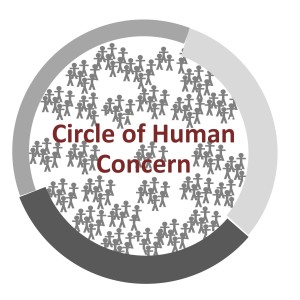
The Circle of Human Concern includes those who are considered full members of society and who can rightfully demand concern and expect full regard in return. Groups that society recognizes as belonging.
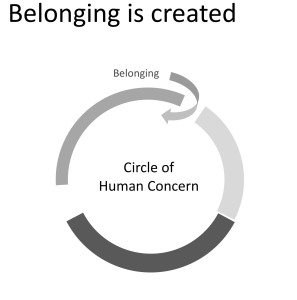
Belonging is created. Laws and practices regulate belonging by protecting the rights of those in power. Historically, legislative decisions pushed groups in and out of the circle of human concern. Many of these decisions are landmark cases that illustrate how society has structurally excluded entire communities of people. These cases still influence how society is structured and how we relate to each other today.
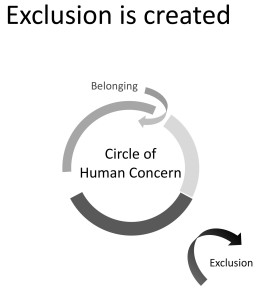
Exclusion is created. Laws, interpersonal and institutional practices such as preferential treatment, prejudice, discrimination, intimidation, vigilante violence, and state sponsored violence create exclusion. Exclusion enables exploitation and marginalization of people.
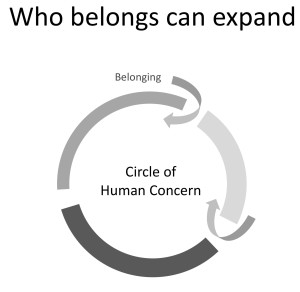
Who belongs can expand. Though the history of the United States is thick with examples of excluding different groups from the circle of human concern, there are periods in which the United States made efforts to expand the circle of belonging. These moments in history affirm the possibility of transforming how our society is structured and how we relate to each other.
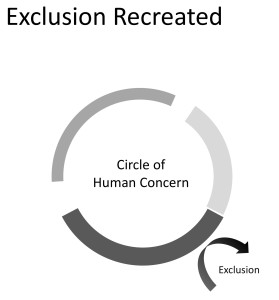
Exclusion can be recreated. Who occupies the space of racial other changes with place and over time. In the United States, while the acute and persistent racial other is the community that is designated “black”, other non-white communities’ membership in society is tenuous and varies depending on the political and economic circumstances. For example, at one time, Iranians and people from the Middle East were considered white. However, current day Muslims, and particularly Arab Muslims are a targeted and criminalized racial other.
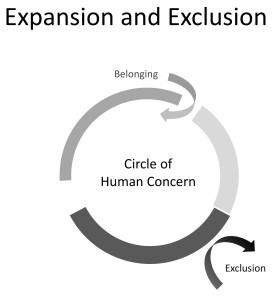
Expansion for some and Exclusion for others. After the Great Depression and World War II, massive expansion of Middle Class wealth accumulation catalyzed through New Deal Era legislation was deeply shaped by white Southern Legislators’ commitment to re-establish racial segregation and female subordination.
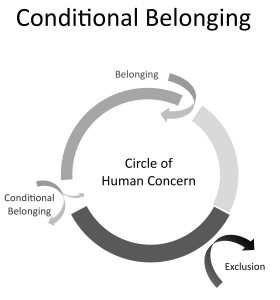
Belonging can be Conditional. Laws and practices can limit belonging, for example, by tolerating limited access by racial others, for example some Asian groups, as long as they remain passive about their own exploitation and/or do not draw attention to the exploitation of other groups.
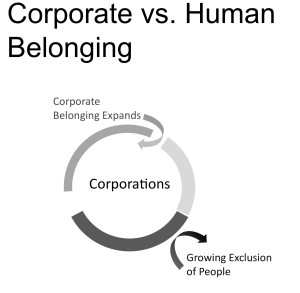
Corporate vs. Human Belonging. With a pervasive post-civil rights narrative that government preferences the despised racial other, support for government as arbiter of justice and oversight erodes. Trust in government is replaced with a belief in unregulated markets, which creates an opening to deregulate and expand corporate rights. All but the most Elite are excluded. The needs of women, gender non-conforming people, homosexual people, and non-white children are subordinated to corporate interests.
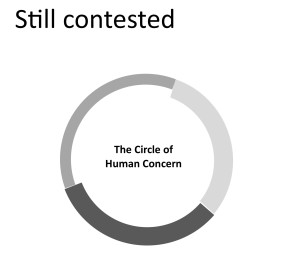
Belonging is still contested. Who is included inside the circle of human concern and who is excluded continues to be contested. Who belongs inside the circle of human concern? You? Me? People or corporations?
Will your action expand the circle of human concern and belonging?
Racial Triangulation
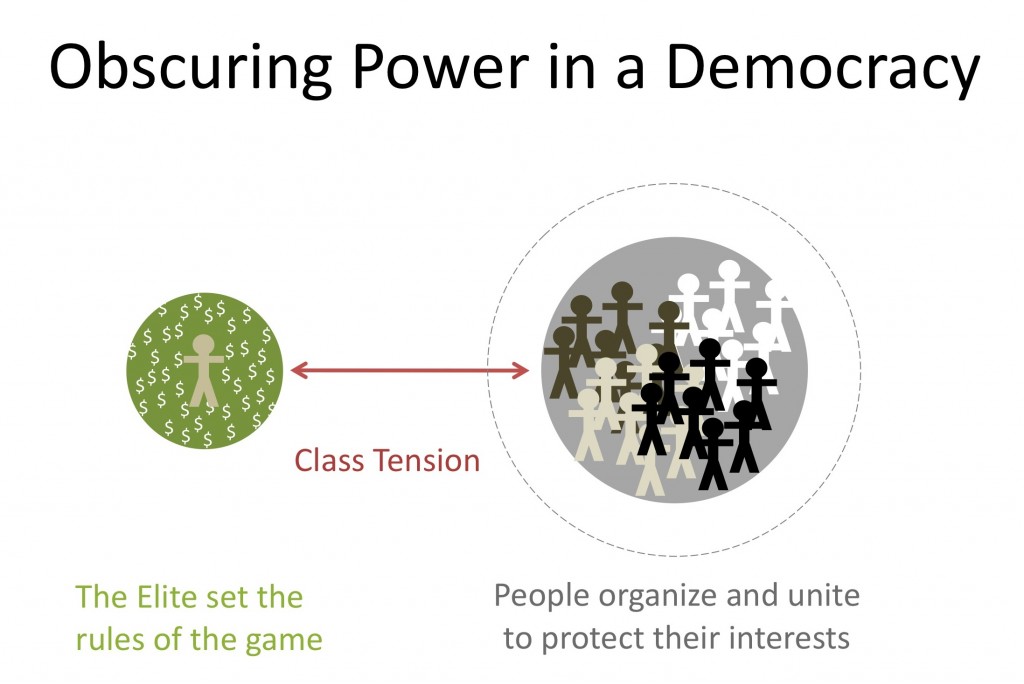
From the founding of the United States, the Elite (owners and primary beneficiaries of corporate power) have limited democratic participation to ensure unregulated access to inexpensive land, exploitable labor, and natural resources. Simultaneously, people have struggled to reign in Elite pursuit of maximum profit through collective action, unions, social mechanisms, and government. The Elite and their representatives use race to divide groups of people to obscure class tension.
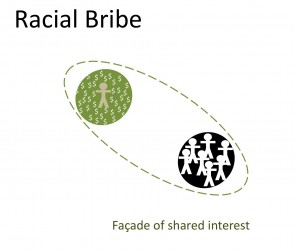
A Racial Bribe refers to an Elite strategy to divide workers along racial lines by creating a façade of aligned interests between white elite and ‘white’ workers. In return, white workers execute the elite’s bidding to receive nominal economic benefit and significant social benefit.
Who is raced ‘white’ changes, but as a group, whites consistently have preferential access to paid work, and have their property and civil rights protected.
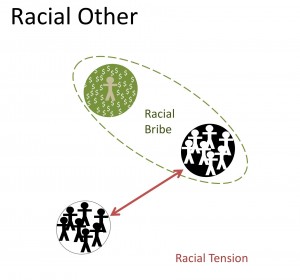
This privileged white identity requires the existence of an oppressed, criminalized racial ‘other’. Without the racial other, defined by systematic exclusion from well paying work, civil rights, and property rights to serve as the contrast to whiteness, white identity would not exist. Who occupies this space of racial other and to what degree changes and adapts to maintain Elite power.
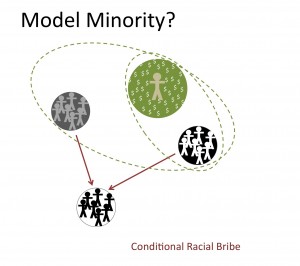
What is the role that non-black non-white racial groups play? When labor demands higher wages or land isn’t freely given, Elite interests need a scapegoat. A non-black non-white racial group is then targeted and excluded, in order to unify other racial groups through targeted attacks. Often the groups targeted have been US citizens for generations, for example of Asian Americans who may be fourth or fifth generation citizens, but are treated as ‘perpetual foreigners’ by virtue of their being racialized.
Through this process of targeting non-black non-white racial groups, Elites benefit from weakened organizing, destabilized wages, cheap land and resources, and further consolidation of capital.
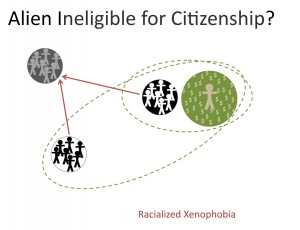
When a non-black non-white racialized group, for example, Asians, Hispanics, or a sub group of either, is introduced into the system, that group is used to reinforce inequity.
Initially that third racial group may be offered a conditional racial bribe as “hard working, non-activist” model minority. However, by accepting the existing racial order (or at least not questioning underlying anti-black prejudice), any perceived success of the group is used to justify continued exclusion black people, while also leaving that group vulnerable to future xenophobic exclusion.
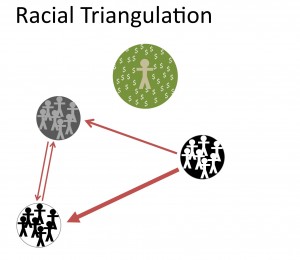
Together, these tactics are called Racial Triangulation. Racial triangulation deflects scrutiny of the economic Elite and of the underlying premises of white innocence and worthiness.
The central organizing principle of the system of racial inequity (black-white racial tension) is reinforced. Non-elite groups of all races, as well as subordinated groups such as women, continue to be marginalized and face backlash when they demand fair treatment.
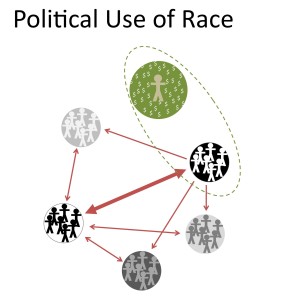
Ultimately, racialization is the outcome of a very complex system designed to distribute power unevenly. New racialized groupings that have no basis–in country of origin, language, biology, phenotypic features, shared history or religious experience–are constantly in formation and flux as the system adapts to the present time.
Through the process of racialization, society collectively creates the contours of economic and political access, while enabling the Elite to continue to amass political power and consolidate wealth.
Belonging Timeline
Belonging:
A visual essay on belonging in the United States Click here to download a pdf of the Othering Belonging Story & TimelineReferences
Bonilla-Silva, Eduardo, Racism without Racists: Color-Blind Racism and the Persistence of Racial Inequality in America, 2009 [colorblind]
Carlsson, Chris and Lisa Ruth Elliott, Ten Years That Shook The City: San Francisco 1968-78, p. 156
Guinier, Lani and Gerald Torres, The Miner’s Canery: Enlisting Race, Resisting Power, Transforming Democracy, Harvard University Press, 2003, p. 226 [racial bribe]
Katznelson, Ira, Fear Itself The New Deal and The Origins of Our Time, Liveright Publishing 2014 [Concessions to Southern Legislators]
Kim, Claire Jean, “The Racial Triangulation of Asian Americans”, Politics & Society, Vol 27 No 1, March 1999, 105-13. [Racial Triangulation]
Lee, Robert G., “Cold War Origins of Model Minority Myth”, Chapter 5 in Orientals: Asian Americans in Popular Culture, Temple Univ. Press, 1999.
Lopez, Ian Haney. White by Law: The Legal Construction of Race, 1997.
powell, john a., Racing to Justice: Transforming Our Conceptions of Self and Other to Build an Inclusive Society, Indiana University 2012
powell, john a., “Poverty and Race Through a Belongingness Lens.” PolicyMatters1, no. 5 (April 2012): 3-23
Said, Edward, Orientalism, 1979 [racial other]
Yu, Frank, Yellow: Race in America Beyond Black and White, NY Basic Books, 2002, p. 21 [perpetual foreigners]
